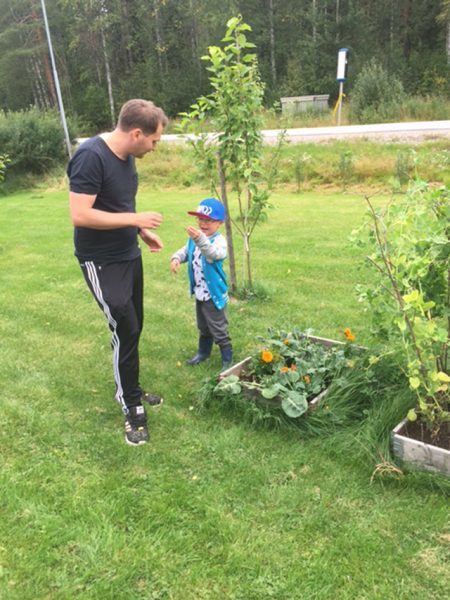Vegetables genetically edited using the CRISPR / Cas9 method, first fried and eaten

The scientific community continues to argue whether the CRISPR / Cas9 genome targeted genome editing method is included in the GMO classification. In conditions of mass public hysteria around the term "GMO" this is an important nuance.
CRISPR (clustered regularly interspaced short palindromic repeats) is a relatively new method for editing the genomes of higher organisms. In 1987, geneticists discovered that bacterial DNA contains short, palindromic identical repeats, between which distinct sections of DNA (spacers) are located. This was not given much importance.
In 2005, it became clear that CRISPR is part of the immune system's mechanism of work, which works like a computer antivirus program. Some spacers correspond to parts of the genomes of harmful viruses (virus signatures). When an organism is infected with a virus, the immune system calculates it using the CRISPR RNA signature and cuts the viral DNA using a specialized Cas protein (CRISPR-associated sequence).
Later it became clear that the “natural” editing of the CRISPR genome works not only in bacterial cells, but also in cells of higher organisms, including humans. Theoretically, this is a very convenient and “natural” way to correct living organisms by cutting out unnecessary sections from a CRISPR cassette or adding new ones there. For example, for a bacterium to become resistant to a virus, simply insert a spacer with the DNA sequence of the virus into the bacterial CRISPR cassette. A painless ideal upgrade to the body’s immune system.
In 2012, scientists from the University of Berkeley brought the theory to life. Genetics professor Jennifer Dudna and colleague Emmanuel Charpentier invented the new CRISPR-Cas9 genome editing technology . Scientists have found a way to get the unnatural CRISPR RNA and, thus, forcing the body’s immune system to cut DNA in areas targeted by the researcher! It was a phenomenal discovery. Scientists all over the world have realized that genetics is on the verge of a new revolution.
It is interesting that scientists from Berkeley filed a patent application 1 day later than colleagues from the Broad Institute at MIT , which is why patent wars are still ongoing between them.
TED lecture by Jennifer Dudna on genetic editing CRISPR / Cas9 (Russian translation)
With the help of an exceptionally accurate “genetic scalpel” it has become possible to treat genetic diseases in humans, to derive new, corrected plant varieties and animal species for the national economy, as well as to easily edit the genomes of human embryos . Genetics has been intensively engaged in such experiments for the past few years.
As can be seen from the description of the CRISPR / Cas9 mechanism, in this case, the body independently, using the natural mechanisms of the immune system, cuts out the wrong portion of DNA at the tip of geneticists. Similar changes in the genome of an organism can occur (and occur) as a result of natural evolution. Here, genetics cannot do anything “unnatural” that could not happen by itself in nature.
However,public obscurantism about GMO for some reason extends to any genome editing methods, including CRISPR / Cas9. But this does not mean that such a position should be taken by regulatory bodies.
For example, Swedish geneticists managed to convince regulatory authorities that plants are not recognized as officially genetically modified organisms in accordance with EU requirements if they do not contain “foreign DNA.”
In fact, the CRISPR / Cas9 technique is inherently such that, based on the result of gene editing, it is impossible to determine whether it was made as a result of human intervention or a natural mutation .
Swedish geneticist Stefan Jansson posted help instructions on his blogfor colleagues from the European Union, in which he explains that the CRISPR / Cas9 genetic experiments and the cultivation of genetically modified plants using the CRISPR / Cas9 method are now not prohibited in all EU countries.
In May 2016, Jansson publicly promised to demonstrate this in practice: grow CRISPR / Cas9 vegetables in his garden with modified DNA, and he kept his promise .
On May 31, Stefan planted cabbage seeds in pots with fertilizers , on June 11 they sprouted , and on June 20 the geneticist transplanted the sprouts to the garden .
Within a month, the scientist fought with cabbage moth and, finally, defeated pests. Perhaps the marigold flowers helped, which he planted on the advice of his wife .
August 16 was the day of the first harvest. Stefan Yarsson cut some leaves for the dining table . To the leaves of cabbage, he added some Swiss chard, peas and onions, which his friend Gustaf brought.

Heated olive oil, the scientist began to fry vegetables.

He mixed cooked pasta with fried vegetables, added local Swedish Västerbotten cheese, herbs and seasonings. And on this beautiful sunny day on August 16, 2016, a scientist gave his friend Gustaf a try to cook a prepared dish.

Thus, colleague Gustaf Klarin (Gustaf Klarin) was the first person in the world who ate a dish of genetically edited vegetables CRISPR / Cas9.

The happy chef at this time fried some bread on a street barbecue, so the dish with genetically modified cabbage became even tastier.

Recipe from Stefan Jansson
300 g of genetically modified cabbage (flowers and young leaves) - can be replaced with broccoli or something similar
200 g of Swiss cheese
20 g of peas
10 onion feathers - can be replaced with a third of onion
Quality olive oil
½ teaspoon of chili pepper shavings
400 g of fresh pasta
100 ml of freshly ground Västerbotten cheese - you can replace with parmesan
50-100 ml of chopped fresh herbs, specifically oregano, thyme, oregano, tarragon and parsley, 2 sheets of coriander, 2 leaves of mint
The cooking method is briefly described and depicted in the photographs above.
Swedish geneticists have not eaten a kilogram dish. To the horror of the "obscurantism of GMOs", scientists treated the child with a genetically modified cabbage .

